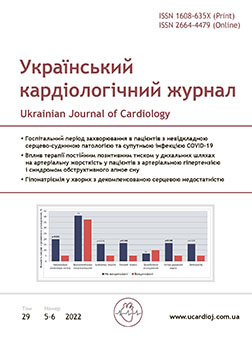Clinical and laboratory parallels in patients with «possible» familial hypercholesterolemia on the background of carbohydrate metabolism disorders
Main Article Content
Abstract
The aim – to investigate clinical and laboratory parallels in patients with «possible» familial hypercholesterolemia (FH) depending on the degree of carbohydrate metabolism disorders.
Materials and methods. The research protocol included 97 patients with CAD, hypertension and dyslipidemia on the background of comorbid pathology (type 2 diabetes, obesity). Patients were divided into 2 groups depending on concomitant comorbid pathology. The obese group was further divided into two subgroups (2A and 2B) depending on the presence of prediabities.
Results and discussion. In the group with diabetes, direct correlations between carbohydrate and lipid disorders were revealed, as well as a high dependence of the level of lipid profile atherogenicity on degree of destabilization of diabetes. In the group with obesity, no significant correlation was found between BMI, WC and changes in the lipid profile. After dividing the obese group into subgroups 2A and 2B, no significant differences in clinical characteristics and lipid profile were found, and there were no correlations between the level of carbohydrate metabolism disorder and lipid changes.
Conclusions. The group of patients with «possible» FH (with LDL-C ≥ 5.0 mmol/l) is heterogeneous and may include patients with secondary dyslipidemia on the background of destabilized comorbid pathology. The percentage of detection of «possible» FH according to the criterion of LDL-C ≥ 5.0 mmol/l was higher in patients with type 2 diabetes and decreased in parallel with the decrease in the degree of carbohydrate metabolism disorders. The absence of direct parallelism and close correlations between LDL-C and the characteristics of the glycemic profile in obese patients with prediabities, which does not exclude the possibility of influence of polygenic genetic mutations on the lipid characteristics.
Article Details
Keywords:
References
ESC/EAS Guidelines for the management of dyslipidaemias: lipid modification to reduce cardiovascular risk. Mach F, Baigent C, Catapano AL, Koskinas KC, Casula M, Badimon L, Chapman MJ, De Backer GG, Delgado V, Ference BA, Graham IM, Halliday A, Landmesser U, Mihaylova B, Pedersen TR, Riccardi G, Richter DJ, Sabatine MS, Taskinen MR, Tokgozoglu L, Wiklund O; ESC Scientific Document Group. Eur Heart J. 2020;41(1):111-88. https://doi.org/10.1093/eurheartj/ehz455.
Visseren F, Mach F, Smulders Y. 2021 ESC Guidelines on cardiovascular disease prevention in clinical practice. Eur Heart J. 2021;42(34):3227-37. https://doi.org/10.1093/eurheartj/ehab484.
Sharifi M, Futema M, Nair D, et al. Polygenic Hypercholesterolemia and Cardiovascular Disease Risk. Current Cardiology Reports. 2019;21(6):43. https://doi.org/10.1007/s11886-019-1130-z.
Medeiros A, Bourbon M. Polygenic contribution for familial hypercholesterolemia (FH). Current Opinion in Lipidology. 2021;32(6):392-5. https://doi.org/10.1097/MOL.0000000000000787.
Мітченко О.І., Романов В.Ю., Чулаєвська Н.М., Тімохова К.О. Сімейна гіперхолестеринемія: етіопатогенез, діагностика, лікування та стан проблеми в Україні // Український кардіологічний журнал. – 2019. – № 4. – С. 23-31. https://doi.org/10.31928/1608-635X-2019.4.2331
Trinder M, Francis G, Brunham L. Association of Monogenic vs Polygenic Hypercholesterolemia With Risk of Atherosclerotic Cardiovascular Disease. JAMA Cardiol. 2020;5(4):390-9. https://doi.org/10.1001/jamacardio.2019.5954.
Cosentino F, Grant PJ, Aboyans V. et al. 2019 ESC Guidelines on diabetes, pre-diabetes, and cardiovascular diseases developed in collaboration with the EASD: The Task Force for diabetes, pre-diabetes, and cardiovascular diseases of the European Society of Cardiology (ESC) and the European Association for the Study of Diabetes (EASD). Eur Heart J. 2020;41(2);255-323. https://doi.org/10.1093/eurheartj/ehz486
Vekic J, Zeljkovic A, Stefanovic A. et al. Obesity and dyslipidemia. Metabolism. 2019;92:71-81. https://doi.org/10.1016/j.metabol.2018.11.005.
Mitchenko OI, Timokhova KO, Chulaievska NM. Diagnostic Features and Selection of Hypolipidemic Therapy in Patients with Coronary Artery Disease with “Possible” Familial Hypercholesterolemia. Ukrainskyi Zhurnal Sertsevo-sudynnoi Khirurhii. 2022;30(3):50-9. https://doi.org/10.30702/ujcvs/22.30(03)/MT041-5059

